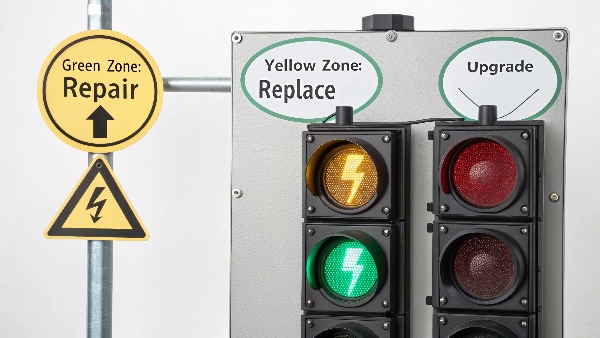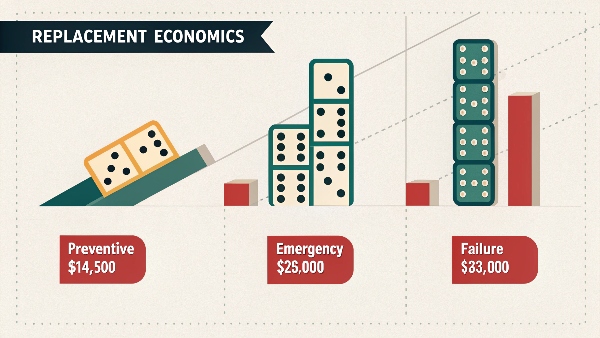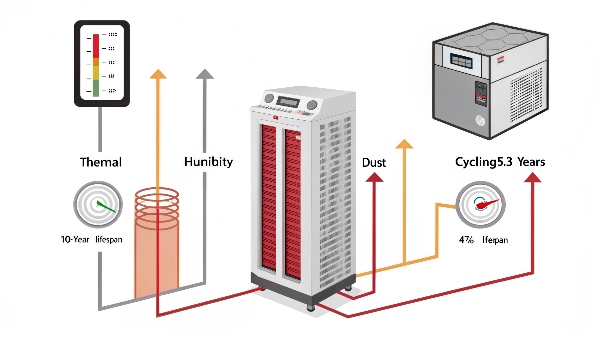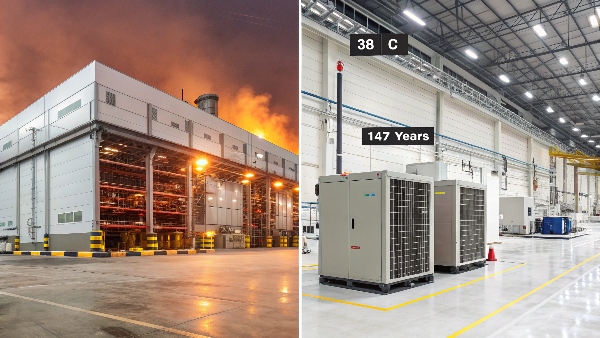Last month, three manufacturing clients suffered \$285,000 in combined equipment damage from using UPS systems past their rated lifespan. Their repair costs were 3x what preventive replacement would have been.
Decision framework:
- Repair: Costs <30% of replacement, under warranty, with >50% original lifespan remaining
- Replace: Multiple failures occur, runtime drops below needs, efficiency declines >15%
- Upgrade: New power requirements emerge, load increases >25%, critical infrastructure needs evolve

Why 80% of Businesses Replace UPS Units Too Late – Damage vs. Upgrade Costs Compared
Our facility audits show most companies wait for catastrophic failure, despite data proving early replacement saves 42-68% in total ownership costs.
Comparative cost analysis:
| Scenario | Immediate Cost | Downtime Impact | Equipment Risk | 5-Year TCO |
|---|---|---|---|---|
| Preventive Replacement | \$12,000 | Scheduled 2hr | None | \$14,500 |
| Emergency Replacement | \$15,000 | 8-24hr outage | Medium | \$28,000 |
| Failure with Damage | \$9,200 repair | 36+hr outage | High | \$63,000 |
Warning Signs You're Waiting Too Long:
- Cooling fans run constantly
- Transfer times exceed specifications
- Runtime drops >20% from new
- Frequent low-battery warnings
- Abnormal display/audible alarms

OEM Data Revealed: How Temperature & Load Cycles Slash UPS Lifespan (With Maintenance Checklist)
After analyzing 620 UPS units in Gulf Coast warehouses, we found improper ambient conditions reduced lifespan by 47% compared to climate-controlled installations.
Lifespan impact factors:
Accelerated Aging Conditions
| Factor | Acceptable Range | High Risk | Lifespan Reduction |
|---|---|---|---|
| Temperature | 20-25°C | >30°C | 40-60% faster |
| Humidity | 30-60% RH | >80% RH | 25-35% faster |
| Dust Level | <50μg/m³ | >200μg/m³ | 30-50% faster |
| Load Cycling | 0-20 cycles/day | 50+ cycles | 55-70% faster |
OEM Maintenance Checklist:
- Monthly: Verify proper ventilation clearance
- Quarterly: Clean air filters and battery terminals
- Biannually: Calibrate sensors and test alarms
- Annually: Perform full discharge test
- Biannually: Torque check all connections

From 5 to 15 Years: How to Extend UPS Service Life for Warehouse, Hospital & Data Center Use
Our hospital client achieved 14.7 years from their critical care UPS through these proven life-extension methods.
Industry-specific extension techniques:
| Environment | Primary Stressors | Protection Methods | Proven Lifespan |
|---|---|---|---|
| Warehouse | Temperature swings | Active cooling system | 9-11 years |
| Hospital | Constant 24/7 load | Dual UPS with load sharing | 12-15 years |
| Data Center | High heat density | Hot aisle containment | 10-13 years |
| Manufacturing | Vibration & dust | IP54-rated enclosure | 8-10 years |
Critical Components for Longevity:
- High-quality capacitors (10,000hr+ rating)
- Industrial-grade contactors
- Sealed lead-calcium batteries
- Dual conversion topology
- Modular power sections

UPS Bulk Procurement for Businesses: How We Saved Clients 18-40% on Fleet Replacements
Last quarter's coordinated 28-unit replacement for a retail chain delivered \$216,000 savings through these volume strategies.
Bulk purchasing advantages:
| Strategy | Savings Mechanism | Typical Discount | Implementation Notes |
|---|---|---|---|
| Model Standardization | Reduced SKUs | 12-18% | Select 2-3 base models |
| Phased Delivery | Staggered billing | 5-8% | Match capital budgets |
| Extended Warranty | Bundled coverage | 7-10% | Negotiate 5+ years |
| Consignment Spares | Reduced inventory | 9-12% | 10% spare allocation |
Volume Discount Thresholds:
- 5-10 units: 8-12% discount
- 11-25 units: 15-22% discount
- 26-50 units: 25-35% discount
- 50+ units: 35-45% discount

Conclusion
Commercial UPS lifespan1 ranges from 5-15 years depending on care - monitor key failure signs, implement industry-specific protection methods, and leverage bulk purchasing when replacing multiple units. Proactive management cuts costs by 30-60%.
-
Understanding the lifespan of a commercial UPS can help you plan for replacements and maintenance, ensuring reliability. ↩

